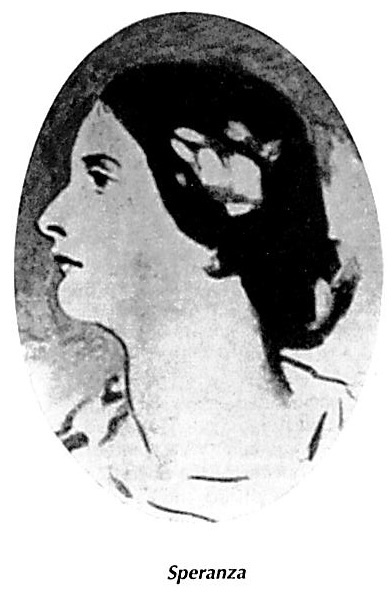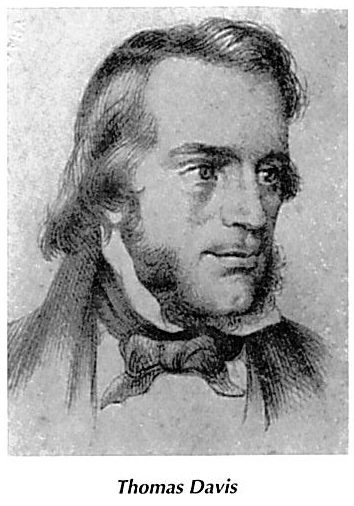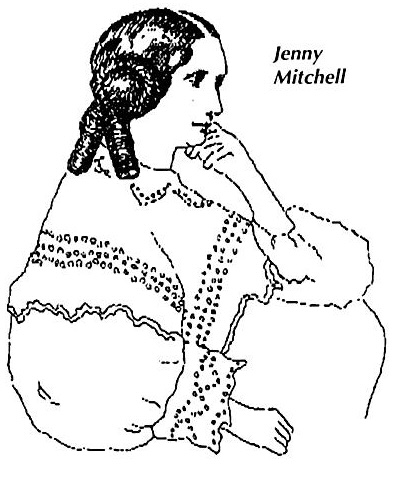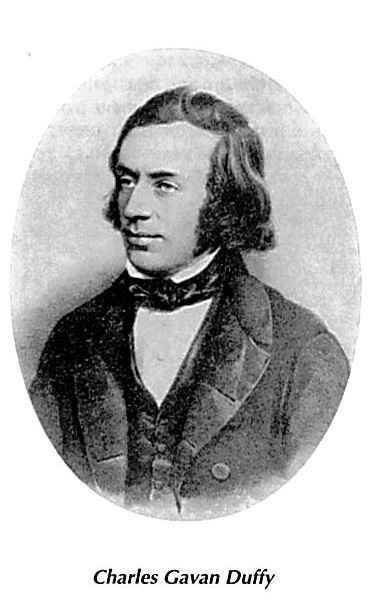by Brigitte Anton
The Nation was the most popular journal in Ireland in the 1840s. Run by a group closely connected with the Repeal movement who became known as the Young Irelanders, it preached an European-style romantic Irish nationalism.
The names of the leaders are familiar: Thomas Davis, Charles Gavan Duffy, John Blake Dillon, William Smith O’Brien, James Fintan Lalor and John Mitchel. However, amongst a wider circle of mainly young people who contributed to The Nation, who distributed it, who went to Repeal meetings or who joined the various societies promoting Irish culture and history, there was a considerable number of women. They were enthusiastic about this kind of Irish nationalism because it gave them a sense of identity. Not much has been written about these women and consequently Young Ireland is seen as essentially a male organisation, which it was not. The Nation in particular offered young women an opportunity to express their national feelings in verse and prose. Most of the women came from well-educated middle-class backgrounds, both Catholic and Protestant. Three groups of women can be distinguished: regular women poets, wives or relatives of male Young Irelanders, and sporadic contributors and activists. At least twenty women are known to have been involved, five of whom were especially active in The Nation.
‘Graces of The Nation‘
The most famous women writers were ‘Mary’, ‘Eva’ and ‘Speranza’the ‘three Graces of the Young Ireland movement’. ‘Maria’ was also extremely popular. Many love-letters were sent to her and received with some hilarity in The Nation office, because as Duffy stated, ‘Maria’ was ‘not only bearded but bloused, an 34 HISTORY IRELAND Autumn 7993 artisan in fact’. Female pseudonyms were very popular amongst male Young Ireland poets, and when reading The Nation one has to be careful not to equate name with gender. Conversely, the poet ‘Wilhelm’ turned out to be Mrs Mary Benn from Cork. Until 1845 there were few women writing in The Nation, and Duffy complained that ‘the fertile brain and passionate soul of woman’ was still wanting. But ‘the long-desired auxiliaries at length appeared.’
‘Mary’
‘Mary’ was Ellen Mary Patrick Downing (1828-1869) from Cork. She started writing poetry for The Nation in May 1845 and by February 1848 forty of her poems had been published. Although not brought up a Speranza nationalist, she was enthusiastic about The Nation and carrying the latest issue in her pocket for constant reference. As a friend later stated ‘we were all Nation-mad’. In 1846 she joined the Cork Historical Society where she met the Young Irelanders Denny Lane and Joseph Brennan. She got engaged to Brennan, but the engagement was afterwards broken off. In February 1848 ‘Mary’ left The Nation and joined John Mitchel’s more radical United Irishman. His arrest and the suppression of the United Irishman was a great disappointment to her. After a nervous fever, she decided to follow a religious vocation and joined the North Presentation Convent in 1849, which however she had to leave due to bad health. She lived as a lay sister, Sister Mary Alphonsus, until her death. Her poems include ‘My Own Sweet River Lee’, The Logic of a Blow’, and The Voice of the Nation’. Her religious poems were published in 1874 in a volume called Voices from the Heart.
‘Eva’
‘Eva’ was Mary Kelly from Headford, County Galway (1830-1910), a country gentleman’s daughter. She started writing prose and poetry for The Nation in 1845 and later also fro the United Irishman, Irish Felon and Irish Tribune. There might also have been a direct influence through her cousin, Young Irelander Kevin Izod O’Doherty in Newgate prison and fell in love with him. He had been arrested for his article in the Tribune. ‘Eve’ shared his radical nationalism and supported his refusal to plead guilty at his trial. Consequently he was transported and the couple were separated for an uncertain number of years. ‘Eva’ had promised to wait for him and married O’Doherty when he was pardoned in 1854. they spend most of their lives in Australia, where ‘Eva’ continued to write patriotic poetry. Amongst her most famous poems are ‘Lament for Thomas Davis’, ‘Down Britannia’, ‘The Men in Jail for Ireland’, and ‘God Save the People’.
‘Speranza’
Anne Fransesca Elgee (1826-1896) was the granddaughter of Archdeacon John Elgee, a Protestant rector from Wexford. She developed an interest in Thomas Davis’s writings after she saw his funeral procession in Dublin and was impressed by the sheer number of mourners. Feeling a strong sense of identification with Davis, because they shared a Protestant background, she began writing translations of continental poetry and political pieces in 1846, first under the pen-name ‘James Fanshawe Ellis’, then as ‘Speranza’. She was held in high esteem for her strong personality , her intelligence, straightforwardness, and strong will — traits which the male Young Irelanders admired as ‘masculine’. One of her articles, ‘Jacta Alea Est’ (The die is cast) was used in the trial against Duffy for publishing seditious material in 1848. ‘Speranza’ had stated:
We must be free! In the name of your trampled, insulted, degraded country;…lift up your right hand to heaven and swear by your undying soul, by your hopes of immortality, never to lay down your arms, never to cease hostilities, til you regenerate and save this fallen land.
Elgee was known to have written the articles but was not arrested. Not only was she a woman but she also came from a highly respectable family. A firm supporter of John Micthel’s radical policy, she was very disappointed by the failure of the 1848 rebellion. She married Dr Wilde in 1852 and is nowadays better known for her son, Oscar Wilde, than for her Young Ireland activities. Her well-known poems include ‘The Voice of the Poor’, ‘The Famine Year’, and ‘The Year of Revolutions’.’
Margaret Callan
Mrs Margaret Callan née Hughes was the sister of Duffy’s second wife, Susan Hughes. She was also his cousin. Coming from a large Newry family, she had to earn her own living at the age of eighteen when her father died. Consequently, she opened a boarding school for girls which she ran successfully with her sisters. Yet she still found time to become involved in the Young Ireland movement and worked in The Nation office. Of the sporadic articles she contributed, only two are known to be definitely by her (most were unsigned), two travel reports ‘A day at Versailles’ and ‘A day in Paris’ which appeared in 1843. Under the pseudonym ‘Thornton Mac Mahon’, she edited The Casket of Irish Pearls, a collection of prose and verse by Irish writers. In its introduction, she urged the Irish people to rely on their own intelligence and power and not to look to England for support or guidance. She seems to have passed on the Young Ireland spirit to her pupils. When communications between the Irish Confederate leaders broke down during the revolutionary activities of 1848, two of her pupils volunteered to re-establish contact. However, Duffy refused to send them down to the disturbed counties, deeming the mission too dangerous for young women. Margaret and her family moved to Victoria in 1856 where she died.
Jenny Mitchel
Jane Verner was born in Newry area, probably in 1820. At the age of sixteen she eloped with John Mitchel and subsequently married him. A strong-willed, independent, yet gentle person, she was involved in The Nation together with her husband, especially when the family moved to Dublin in 1845 The Mitchel home became a centre for Young Ireland meetings. She was more than just a housekeeper but rather a full participant in all political activities, like John’s sisters Henrietta and Mary Jane. Her work included reading newspapers and keeping files on articles for further use in The Nation or in John’s writings. When John Mitchel seceded from the journal and founded the United Irishman in 1848, the Mitchel women became involved in the enterprise, writing anonymous articles, editing contributions, reading newspapers and undertaking all necessary work connected with the journal. Politically she fully supported John’s radical ideas and when he was arrested in May 1848 her staunch attitude was admired by Young Ireland supporters. Her sufferings were compared to the sufferings of Ireland. Funds were raised for her and her family. It was Jenny Mitchel’s belief that nobody should leave Ireland in a convict’s shop and she was bitterly disappointed when John was transported without a fight. She remained involved in Young Ireland activities and helped, for instance, Thomas Devin Reilly escape to America. In the United States, where she worked again on John’s various newspapers, she was also engaged in fund-raising for Fenian prisoners. She died in 1899.
Writings on and by women
Despite their input into the movement, women ere not usually mentioned in the writings o Young Ireland. In the volumes of The Nation 1842-8 they are rarely included in prose or political texts. If they are referred to at all it is usually in connection with suffering to show the desperate situation of Ireland. Strongly romanticized, women are seen as the inspiration for men’s patriotic behavior. Thus there was a strong desire to recruit women into the national movement or at least to encourage them to think in a nationalist way. One of the few articles specifically on women explains:
The Mission of Women
We are constantly hearing that ‘women have no business with politics.’ This we deny…active patriotism is a duty bearing equally upon man and woman…The world says, too, that ‘women are not to meddle in politics’; and if by this is meant meddling publicly, the world is right. This is not a woman’s sphere, and we should more deeply regret to see her so ‘unsex’ herself, than we now deplore the unfulfilled duty which in her province…A woman’s sphere is in her home, her school, her fireside, where she has all holy things to teach…
This article demonstrates that many Young Irelanders preferred the application of women’s intelligence in the home. There, women’s subtle influence was very much desired whereas public appearance and involvement were frowned upon.
In their poetry, the women writers of The Nation expressed the same ideas as the men up to 1848, in particular in the love-songs. Likewise, letter-writers with female names, when dealing with politics, followed the mainstream Young Ireland line and did not emphasis a women’s participation in the movement. Nevertheless there were indications that some women were radical emphasising more action and less rhetoric. Thus when receiving a poem from a female contributor, the editor in 1846 wrote emphatically: ‘Our lady correspondents are becoming more manly than the men themselves…’ In the same year, the idea for a series on Illustrious Irishwomen was mooted. But it took editors two years to start the series, whereas the series on Illustrious Irishmen had been up and running for some time.
Women feature more prominently in the revolutionary year of 1848. The women themselves encouraged other women to get involved in the nationalist movement. Thus, ‘Eva’ wrote to the editor of The Nation in 1848, addressing the women of Ireland:
No woman, no more than a man, is exempt from aiming at all the perfection of which the human soul is capable. what is the virtue in man is virtue also in woman. Virtue is of no sex. A coward woman is as base as a coward man…t is not unfeminine to take sword or gun, if a sword or gun are required…Plead no in this hour the miserable excuse — ‘I am a woman…’.
‘Mary’ also appealed to the women of Ireland in the United Irishman:
‘A woman should never forget her sex’ sounds to all ears like a mere truism; yet absolutely but few of our ladies can be said to understand their womanhood, its privileges and its duties… A horror of bloodletting appears to be regarded as the feminine virtue in Ireland… It were more womanly to choose great blood-letting and small pain rather than avarice of blood and prodigality of suffering… Do you believe famine to be milder than the sword?
Men like John Mitchel and Thomas Francis Meagher also wanted women to take a more active part in the struggle for national self-determination. The Nation and other Young Ireland journals were focusing on all activities and thoughts on a nationalist revolution and so needed to embrace all sections of the Irish population. Therefore, the new series Illustrious Irishwomen featured Matilda Tone whose life was discussed over six issues. Her biography had not been completed when The Nation was suppressed in July 1848 and the series was not continued when the journal reappeared in 1849. By then times had changed and revolutionary fervour had faded into disillusionment. Consequently women were pushed back into private sphere — all the more so with the transformation of society after the Famine. Thus the original intention of the series became irrelevant.
Activities by women
Female Young Irelanders were not only busy writing but were also engaged in public activities. Those who went to the meetings of the Loyal National repeal Association and made their voices heard by cheering were breaking with the passive romantic ideal. When the split between Young Ireland and the Repeal Association occurred in July 1846, the women showed their support for the former by walking out of the hall. they also attended the trials of the young Irelanders.
In 1848 many women writers extended their activities into the revolutionary sphere when there was a stronger demand for female involvement. ‘Mary’, ‘Eva’, ‘Speranza’ and Jenny Mitchel strongly believed in the success of an uprising whereas Margaret Callan followed Duffy’s more cautious line. By July 1848 Margaret Callan and ‘Speranza’ were running The Nation on their own when most of the male Young Irelanders were either arrested or on the run. This highly risky enterprise was absolutely necessary to sustain publicity about Young Ireland activities. Charles Gavan Duffy later acknowledged their contribution:
Before the number was issued the police were sent to seize and carry off the type, the manuscripts, and the proofs. When they took possession of the establishment they found a lady* in the editors room, and the journal ready to be issued. The manuscript of the number on which they had laid their hands consisted in a large degree of articles in two handwritings, both of them plainly feminine.
* The courageous woman found in control of The Nation office was Margaret Callan, my sister-in-law; the author of ‘Jacta Alea Est’ was Speranza, the present Lady Wilde. Two women of genius.
Women tried to maintain contact between the rebels when they were cut off from Dublin or on the run. They also kept in contact with each other. Thus for some of the women necessity forced them into activities which they might not have envisaged when they first got involved. They were suddenly driven into revolutionary activity.
Conclusion
In the Young Ireland movement women were not only auxiliaries in the background but contributed to the success of The Nation, particularly through their poems. By 1848 their input was increasingly acknowledged by the Young Irelanders and a stronger participation in revolutionary activity was required. However, many male Young Irelanders and a stronger participation in revolutionary activity was required. However, many male Young Irelanders did not always welcome this because their ideal was the romanticized woman — the female on a pedestal. Most male Young Irelanders preferred indirect female involvement rather than a direct and public role, but necessity forced them to accept increased female participation.
the views of many female Young Irelanders on the role of women in the movement developed as well. Enthusiasm for Irish nationality and Irish national self-determination changed their outlook on life, gave them a new sense of identity, induced them to do unusual things, and allowed them to break out of middle-class female routine. By 1848 they could self-consciously demand greater participation in the movement and in the anticipated national uprising. Although they were not ‘feminist’, they certainly wanted to play their part in the national struggle, whether it meant stimulating nationalist emotions in writing, or plunging into revolutionary activity, incurring high personal risks. Their radicalism was unusual for their time. The contribution of these women activists has not been sufficiently acknowledged by historians; only by including them does one get a full picture of the Young Ireland movement.
Brigitte Anton is a postgraduate research student in the Dept. of Modern History, Queen’s University, Belfast.
Further reading:
T. De Vere White, The Parents of Oscar Wilde (London 1967).
‘Ellen Downing “Mary of the Nation”‘, series in Irish Monthly vol 6 (1878), vol 12 (1884) and vol 36 (1908).
R. O’Connor, Jenny Mitchel, Young Irelander (Tuscon 1988).
R. and H. Patrick, Exiles Undaunted: the Irish rebels, Kevin and Eva O’Doherty, (Brisbane 1989).




